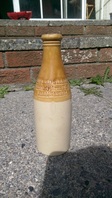|
By Damian Mac Con Uladh The “Clancarty Arms Hotel, Ballinasloe” didn’t ring a bell. Nor did the name “Edward Steacie”, also imprinted on the stoneware bottle, sound in any way familiar.
Corbett’s, Hogan’s and Cuffe’s were historical hotels in the town that I was aware of. But Steacie’s and the Clancarty Arms? I was determined to find out more. The bottle didn’t have a message inside it, but I thought there must a message about it. So, I took a few snaps of the two-tone, cream and beige-coloured vessel, which I’d spotted sitting on a shelf alongside an array of bottles as I was leaving Ganly’s house on Dunlo Hill, which I visited on a recent trip home. Conor Ganly is sure his late father, Mattie, found it on the Fair Green “years ago after a fair day”. A quick search on Google revealed that the Clancarty Arms was located “close to the railway station” – obviously it’s the building that I’d always known as the Railway Hotel. In more recent times, it served as the headquarters for the local FCA company. A small Tudor-Gothic building, it was built around 1863, more than a decade after the railway came to Ballinasloe in 1851. Visible on the half dormer window above the door, the arms of the earls of Clancarty, the local landlords based in Garbally, inspired the name that the hotel would take. In 1864, some months after the hotel opened, the dozens of causalities from a train derailment that cost two people their lives were taken there for medical attention. In 1870, a newspaper report identifies Edward Steacie (also spelled Stacie) as the hotel’s proprietor. Ironically, he appeared at the petty sessions (with the actual Lord Clancarty in the chair), where he was charged for serving non-travellers drink on a Sunday. In 1860, Steacie, whose origins I have not been able to establish, married a local woman, Anne Galbraith, a schoolmistress and daughter of John Galbraith, a farmer. The couple seemingly spent a few years in Co Longford (their first child, Mary, was born in Newtownforbes in 1861) before moving back to Ballinasloe. Five more children would follow: John, Edward, Richard, Kathleen and Anne. In 1864 Steacie became clerk to the Ballinasloe Town Commissioners, the forerunner of the late and much lamented Town Council. Also clerk of the local gas company, he ran the hotel business at the same time. By 1882, Steacie was no longer involved with the Clancarty Arms, which was being run by Julien Gauthier, a Frenchman who had been chef for Lord Clancarty for 30 years. He lived on Dunlo Hill and decided to enter the hotel business after inheriting “money and property to the value of £15,000”. In November 1882 he married a Clancarty servant, Margaret Kearns from Killoran. However, a few days later, “he rose at six o’clock and shot himself with a revolver”. As the Pall Mall Gazette recorded, “by the marriage settlement the wife is comfortably provided for”. The nature of Gauthier’s death is almost certainly the source of the local belief that the building is haunted. But back to the Steacie family. By the late 1880s, Anne and most of her children had emigrated to Canada, where she died in 1888, while her husband remained in Ballinasloe, continuing as town clerk until his death in a Galway hospital at the age of 58 in 1897. Of their children’s fate’s, Richard’s is the most fascinating. On the outbreak of the First World War in 1914, he lied about his age – he was too old at 46 – to join the military. He became a captain in the 14th Battalion (Royal Montreal Regiment) of the Canadian Expeditionary Force. On 22 April 1915, the day the second battle of Ypres began, Steacie, dug into a trench with the stench of green chlorine gas hanging above, was killed when a German bullet ripped into his neck. According to the Toronto Sun, his men been asked to step up and hold a front line that the Germans had burst through. Steacie, who was shouting orders when hit, was the first Royal Montreal Regiment officer to be killed. Amid the chaos of war, his remains were not identified, so he was buried under an anonymous headstone inscribed “A captain of the Great War. 14th Bn. Canadian Inf.” However, 98 years later, thorough research by Michel Gravel, a roofer and history buff from Ontario, led to the identification of Capt Richard Steacie’s grave and the placing of a new headstone on it. Incidentally, Steacie’s only son, Edgar William Richard Steacie (1900–62), became a prominent Canadian physical chemist. The Steacie Science and Engineering Library at York University, Toronto, and the Steacie Building for Chemistry at Carleton University, Ottawa, are named in his honour. The stories bottles can tell! (Damian Mac Con Uladh is a freelance journalist based in Greece)
0 Comments
Leave a Reply. |
CLICK HERE to read the Latest Ballinasloe News Articles
March 2024
|
The Town Team was set up by BACD Ltd. to revive the fortunes of Ballinasloe and its hinterland. With the main focus to build on the town’s many strengths, change existing negative perceptions and bring about measurable improvements in the town centre economy and its wider social value.
|
Ballinasloe Area Community Development Ltd.
Ballinasloe Enterprise Centre Creagh Ballinasloe Co. Galway |
All generic photos and images have been sourced and are free of copyright or are clip art images free of copyright. Photos of Ballinasloe have been donated by BEC. If you have any photos that you would like included on the website please email us
Copyright © All rights reserved, 2023 BACD


 RSS Feed
RSS Feed
